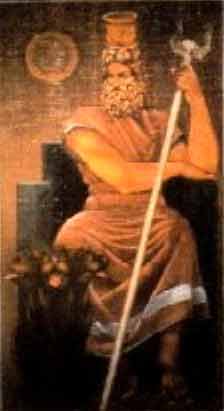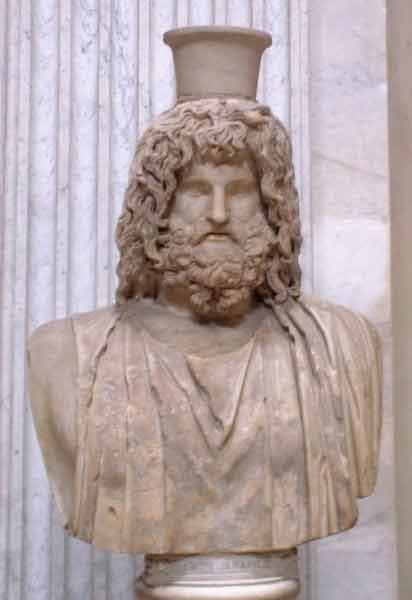.

The Hellenistic-Egyptian god Serapis.
Serapis was an Hellenistic-Egyptian god in Antiquity. Under Ptolemy Soter, efforts were made to integrate Egyptian religion with that of their hellenic rulers. Ptolemy's policy was to find a deity that should win the reverence alike of both groups, despite the curses of the Egyptian priests against the gods of the previous foreign rulers (i.e Set who was lauded by the Hyksos). Alexander had attempted to use Amun for this purpose, but he was more prominent in Upper Egypt, which was not so popular with those in Lower Egypt, where the Greeks had stronger influence. Nethertheless, the Greeks had little respect for animal-headed figures, and so a Greek statue was chosen as the idol, and proclaimed as anthropomorphic equivalent of the highly popular Apis. It was named Aser-hapi (i.e. Osiris-Apis), which became Serapis, and was said to be Osiris in full, rather than just his Ka.
The earliest mention of a Serapis is in the authentic death scene of Alexander, from the royal diaries (Arrian, Anabasis, VII. 26). Here, Serapis has a temple at Babylon, and is of such importance that he alone is named as being consulted on behalf of the dying king. His presence in Babylon would radically alter perceptions of the mythologies of this era, though fortunately, it has been discovered that the unconnected Bablyonian god Ea was titled Serapsi, meaning king of the deep, and it is this Serapsi which is referred to in the diaries. The significance of this Serapsi in the hellenic psyche, due to its involvement in Alexander's death, may have also contributed to the choice of Osiris-Apis as the chief Ptolemaic god.

Copy of the Serapis bust of Bryaxis in the Serapeion in Alexandria, Pio-Clementino Museum, Vatican (Inv. 689) , Image by Jastrow (2003)
According to Plutarch, Ptolemy stole the statue from Sinope, having been instructed in a dream by the unknown god, to bring the statue to Alexandria, where the statue was pronounced to be Serapis by two religious experts. One of the experts was the one of the Eumolpidae, the ancient family from whose members the hierophant of the Eleusinian Mysteries had been chosen since before history, and the other was the scholarly Egyptian priest Manetho, which gave weight to the judgement both for the Egyptians and the Greeks.
Plutarch may not however be correct, as some Egyptologists allege that the Sinope in the tale is really the hill of Sinopeion, a name given to the site of the already existing Serapeum at Memphis. Also, according to Tacitus, Serapis (i.e. Apis explicitely identified as Osiris in full) had been the god of the village of Rhacotis, before it suddenly expanded into the great capital of Alexandria
The statue suitably depicted a figure resembling Hades or Pluto, both being kings of the Greek underworld, and was shown enthroned with the modius, which is a basket/grain-measure, on his head, since it was a Greek symbol for the land of the dead. He also held a sceptre in his hand indicating his rulership, with Cerberus, gatekeeper of the underworld, resting at his feet, and it also had a what appeared to be a serpent at its base, fitting the Egyptian symbol of rulership, the uraeus.
With his (i.e. Osiris') wife, Isis, and their son (at this point in history) Horus (in the form of Harpocrates), Serapis won an important place in the Greek world, reaching Ancient Rome, with Anubis being identified as Cerberus. The great cult survived until 385 AD, when early Christians destroyed the Serapeum of Alexandria, and subsequently the cult was forbidden by the Theodosian decree.
References
E. R. Bevan: The House of Ptolemy, Chapter. II
See also : Greek Mythology. Paintings, Drawings
| Ancient Greece
Science, Technology , Medicine , Warfare, , Biographies , Life , Cities/Places/Maps , Arts , Literature , Philosophy ,Olympics, Mythology , History , Images Medieval Greece / Byzantine Empire Science, Technology, Arts, , Warfare , Literature, Biographies, Icons, History Modern Greece Cities, Islands, Regions, Fauna/Flora ,Biographies , History , Warfare, Science/Technology, Literature, Music , Arts , Film/Actors , Sport , Fashion --- |
Retrieved from "http://en.wikipedia.org"
All text is available under the terms of the GNU Free Documentation License

